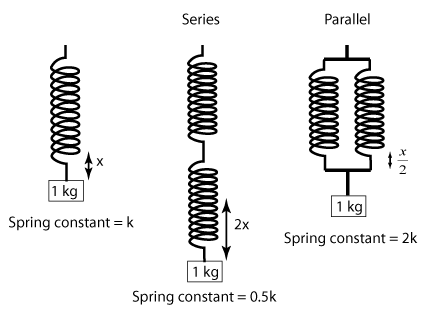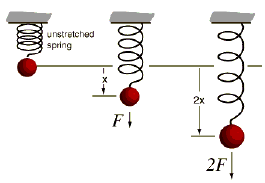Spring Motion: Difference between revisions
No edit summary |
No edit summary |
||
| (One intermediate revision by one other user not shown) | |||
| Line 21: | Line 21: | ||
Try an initial mass location to give a straight vertical path! | Try an initial mass location to give a straight vertical path! | ||
= | = Spring Stiffness= | ||
[[File: | [[File:Springs.gif]] | ||
The spring stiffness <math> k_s </math> is a constant for each individual spring and is important for comparing the forces of different spring systems. | |||
We can consider attaching multiple springs of the same length and stiffness in a system to create a new larger spring and examine the change in spring stiffness by measuring the distance stretched with the same force applied to the spring system. | |||
For example, if you attach two of the same spring in parallel, the spring stiffness will be twice the value for one of the springs because you have to account for pulling against the force of two springs simultaneously. | |||
However if you attach two of the same spring in series, the spring stiffness is half of what it is for one spring. This is because, for the same force, each spring stretches the same length as it would by itself. | |||
[[File:Series.png]] | |||
==Connectedness== | |||
Spring motion can be found throughout nature. If you consider the bouncing movement of kangaroos, you can use the concepts of spring motion to model the role of spring-like tendons in their hips. | |||
==History== | |||
This concept of motion stems directly from Sir Isaac Newton's Third Law of Motion: "For every action, there is an equal and opposite reaction" which was published in his work the ''Philosophiae Naturalis Principia Mathematica'' in 1687. This can be modeled well with a spring. As you (or gravity and a weighted mass) stretch one end of a spring, the spring pulls back based on our model of its force. | |||
[[File:Newton.jpg|right|200px|alt=Sir Isaac Newton.|Sir Isaac Newton.]] | |||
== See also == | == See also == | ||
Check out the [[Newton's Second Law: the Momentum Principle]] page to learn more about net force's affect on the momentum, velocity, and position of an object. | |||
== | ==References== | ||
Editors, B. c. Isaac Newton Biography. from http://www.biography.com/people/isaac-newton-9422656 | |||
Elasticity. from http://www.one-school.net/Malaysia/UniversityandCollege/SPM/revisioncard/physics/forceandmotion/elasticity.html | |||
Sound Propogation in Elastic Materials. from https://www.nde-ed.org/EducationResources/CommunityCollege/Ultrasonics/Physics/elasticsolids.htm | |||
[[Category:Momentum]] | [[Category:Momentum]] | ||
Latest revision as of 13:25, 23 May 2019
by Caroline Ware
Spring Motion
While the momentum you have dealt with before may have followed a linear path based on a constant force, spring motion is involved with a changing net force. As you may have noticed when trying to compress or stretch a helical spring, it resists motion (with high opposing force) most when its length is farthest from the relaxed length in either direction. This force alone would indicate a movement along the length and direction of the spring, oscillating based on the addition of a mass.
A Mathematical Model
The Force due to a spring follows the relationship [math]\displaystyle{ F_{spring} = -k_s*s*L_{hat} }[/math] where [math]\displaystyle{ k_s }[/math] is the specific stiffness of the spring, [math]\displaystyle{ s }[/math] is the change in length of the spring from the current to the relaxed length [math]\displaystyle{ s= L - L_0 }[/math] and [math]\displaystyle{ L_{hat} }[/math] is the unit vector indicating the direction of the vector pointing from the spring's origin to the mass.
Spring motion can be predicted using the momentum principle [math]\displaystyle{ dp=F_{net}*dt }[/math] and the position-update formula [math]\displaystyle{ dr= p_f/m*dt }[/math] Because spring motion involves oscillation, it is important to iterate with a small enough change in time to capture the full path of the spring-mass system.
A Computational Model
Follow the link to check out a 3D model of Spring Motion. The code displays a spring with one fixed end on a ceiling and a mass attached to the free end. https://trinket.io/glowscript/3587ff8cbe The pink arrow represents the magnitude and direction of the mass's momentum. The yellow arrow represents the changing net force, Force of gravity + Force of the spring, on the mass (scaled down to 10%). Examine the orange curve after the simulation ends to follow the path of the mass's motion. Try an initial mass location to give a straight vertical path!
Spring Stiffness
The spring stiffness [math]\displaystyle{ k_s }[/math] is a constant for each individual spring and is important for comparing the forces of different spring systems.
We can consider attaching multiple springs of the same length and stiffness in a system to create a new larger spring and examine the change in spring stiffness by measuring the distance stretched with the same force applied to the spring system.
For example, if you attach two of the same spring in parallel, the spring stiffness will be twice the value for one of the springs because you have to account for pulling against the force of two springs simultaneously.
However if you attach two of the same spring in series, the spring stiffness is half of what it is for one spring. This is because, for the same force, each spring stretches the same length as it would by itself.

Connectedness
Spring motion can be found throughout nature. If you consider the bouncing movement of kangaroos, you can use the concepts of spring motion to model the role of spring-like tendons in their hips.
History
This concept of motion stems directly from Sir Isaac Newton's Third Law of Motion: "For every action, there is an equal and opposite reaction" which was published in his work the Philosophiae Naturalis Principia Mathematica in 1687. This can be modeled well with a spring. As you (or gravity and a weighted mass) stretch one end of a spring, the spring pulls back based on our model of its force.

See also
Check out the Newton's Second Law: the Momentum Principle page to learn more about net force's affect on the momentum, velocity, and position of an object.
References
Editors, B. c. Isaac Newton Biography. from http://www.biography.com/people/isaac-newton-9422656
Elasticity. from http://www.one-school.net/Malaysia/UniversityandCollege/SPM/revisioncard/physics/forceandmotion/elasticity.html
Sound Propogation in Elastic Materials. from https://www.nde-ed.org/EducationResources/CommunityCollege/Ultrasonics/Physics/elasticsolids.htm
